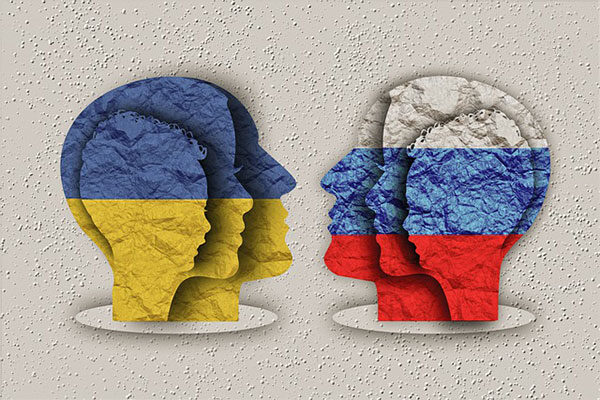Implications of the Russia-Ukraine War on the Russian Economy

By Tony Tsao, MBA ’22
The Russian economy is set to take a turn for the worse this year. Since Russia’s invasion of Ukraine in February, businesses have been fleeing the economy, whether due to economic risk or to take a stance against the invasion. Sanctions from other governments and organizations are also taking their toll.
According to former Russian finance minister Alexei Kudrin, the country’s GDP is projected to decline more than 10 percent in April, aligning with projections from renowned financial institutions’ projected declines, including the Institute of International Finance (15 percent) and Goldman Sachs (10 percent). On top of high inflation, Russia’s domestic productivity readings also signal contraction. Manufacturing PMI and service PMI both are seeing historical declines in the month of March, likely due to decreased domestic and foreign demand. Consumer confidence continues to decline.
The ruble rally: Resilience or manipulation?
Despite all odds, the Russian currency, the ruble, has staged a great comeback from its March low. The currency has appreciated 96 percent from its low point on March 8, 2022, to a point slightly higher than its pre-war level. This is a stark difference from its deteriorating economic fundamentals, as well as its stock market performance. MOEX, the Moscow stock index, although up slightly from its low point, is still down 32.9 percent from its pre-war level. Normally, a currency’s value fluctuates in the same direction as its underlying economic performance, which is not the case with the ruble. This contradiction begs an important question: Is this strengthening of the ruble a sign of economic resilience or a result of manipulation? The answer is that the rally of the ruble is a result of the world’s heavy reliance on Russia’s energy exports and extreme intervention from the Russian government.
Global demand for energy remains strong
Russia is one of the top exporters of crude oil and natural gas, especially to its neighboring economies in the Eurozone. According to Eurostat, Russia accounts for 24.8 percent and 39.2 percent of the European Union’s (EU) petroleum and natural gas imports, respectively. Although EU countries have brought numerous ways of sanctioning Russia to the table, the hard reality is that it is nearly impossible, in such a short time period, to seek alternative sources of energy to replace Russia’s contribution, which is around one-quarter of total oil usage for the EU.
Countries such as the United States, Canada, and Britain have imposed a complete ban on Russian oil, but the EU has not yet reached any form of agreement. This reliance on Russia, together with the high and rising oil price, greatly helped Russia offset its poor economic performance. As a result, Russia’s current account rose from $46,564 million to $58,200 million in March, despite its domestic demand and production remaining significantly subpar. However, this may not last long: According to EU economic commissioner Paolo Gentiloni, the EU will reduce its reliance on Russian imports by two thirds by the end of the year, and reduced it to zero by 2027.
Russia’s efforts to artificially strengthen the ruble
Russian intervention is also apparent. As a first step, Russia more than doubled its interest rate from 9.5 percent to 20 percent. The greater return from the higher rate makes investing in Russian assets more attractive, relieving capital flight pressures. The Russian government also imposed a series of capital control policies to keep the ruble from weakening. Russian goods and services exporters are required to sell 80 percent of their foreign currency revenues for rubles, pumping up its value. The government also imposed restrictions on Russian citizens’ ability to transfer money to foreign currency, effectively limiting the disposal or sales of the ruble in the market. Last but not least, capitalizing on the high demand for energy, Russia mandated that any foreign entity that is importing oil and gas from Russia has to set up a special account with a Russian bank, through which the payments denominated in foreign currencies will be transferred to rubles before paying suppliers. This policy has proven to be more than just a bluff: Russia cut gas supplies to Bulgaria and Poland for failing to pay in rubles. These market intervention policies helped the ruble bounce back from its low point and the rebound does not look like a short-lived one. The question is how long Russia can keep up with these measures given their currency reserve level, and whether this artificial supply and demand of the ruble will cause further inflation in the economy.
What to expect in a post-war Russian economy
The war has economic and financial implications far beyond the Russian border. Many countries will start rethinking their supply chain strategies to mitigate disruption. Some in the EU are already making plans to reduce their dependence on oil and gas imports from Russia. This may also create extra incentive for companies to transition to adopting renewable energy or at least seek better energy independence.
Currency risk has also been a big concern. In the future, Russia may seek not only to improve its currency independence through denominating transactions in non-Western currencies, but also to strengthen its financial ties with its allied countries to create a de-dollarized financial system. India and China are reportedly in talks with Russia to co-create a linked financial system that will provide a currency-exchange mechanism without the intervention of Europe or the United States. This could provide an incentive for countries that are more susceptible to Western sanctions to join. Also, because Russian assets in foreign banks can be easily frozen by sanctions, wealthy individuals and government officials will attempt to de-risk through seeking alternative options to safeguard their assets. Crypto-currency exchange platforms are mostly decentralized; therefore, they would serve as favorable places to hedge against sanctions.
Lastly, the war will bring about a reframing of geopolitical relationships, and regionalization may take the place of the rapid globalization of the past decades. This will hit not only at the national level, but also at the corporate one. Multinational companies will have to redefine their operational strategies and review their stances for or against economic or political entities as conflicts that disrupt the global market and the global financial system may occur on a more frequent basis.
About Tony Tsao, MBA ’22

Tony Tsao is an MBA candidate in the Two-Year MBA class of 2022. Before coming to Johnson, he worked in the financial services sector as a financial market analyst in Taiwan. After Johnson, Tsao will be pursuing a career in management consulting.
